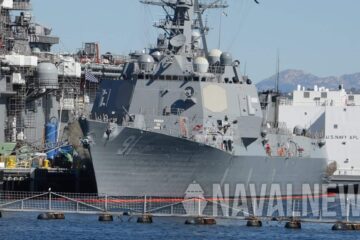NAVAIR press release
This teamwork, including the organization and facilitation of an Arresting Hook Summit by PMA-265 personnel, allowed the program office to dramatically reduce numbers of Issue Priority Group 1 (IPG1) aircraft and arresting hook back orders, said Mark Harris, the PMA-265 Landing Gear deputy assistant program manager for logistics (DAPML).
“Without several key assists from PMA-265, this shortfall could not have been reversed,” Harris said.
The arresting hook shortfall, which affected both F/A-18 Super Hornet and EA-18G Growler aircraft due to their shared airframe, was identified by NAVAIR nearly four years ago and was the result of the shutdown of the sole arresting hook repair facility, Harris said.
Bruce McIntosh, PMA-265 landing gear systems contractor support services, said NAVAIR Fleet Support Team (FST) provided notice about a processing error, identifying 151 subcomponents of the arresting hook assembly that needed to be replaced. The notification stipulated that aircraft found ashore with these subcomponents should not deploy, and aircraft that were already deployed were required to be inspected within 43 traps. After 43 traps, the tail hook components would be removed and turned in for maintenance. Affected hooks were moved to non-deploying aircraft in order to limit grounded aircraft.

McIntosh and PMA-265 Landing Gear DAPML Rick Lee discovered the demand for arresting gear hooks was much higher than the official 10 per month, something that was not immediately apparent. McIntosh and Lee notified NAVSUP, prompting them to start making spares purchases, searching for other sources to make repairs and begin the process of getting a contract for approximately 900 spare arresting hooks.
McIntosh and Lee set up an Arresting Hook Summit at Naval Air Station Oceana, Virginia, in 2018 to discuss ways to address arresting hook back orders and mitigate IPG1s, McIntosh said. They developed a plan with NAVAIR engineering for an extension on how many traps an arresting hook could perform in order to reduce the demand for spares and presented the plan to leadership at the summit.
A 10 percent extension, from 300 to 330 traps between overhaul requirements, was initially authorized by Program Executive Office for Tactical Aircraft Programs (PEO(T)), with extensions up to 400 and 500 traps being authorized on a case-by-case basis followed by the immediate removal from service upon reaching the extended life span.
“I was honored to have had a hand in the process of getting this extension approved,” said McIntosh.

The extension of traps combined with the qualification of two new tail hook repair sources and an aggressive delivery schedule for spares ultimately allowed PMA-265 to go from 73 IPG1s and over 150 back orders to zero IPG1s and roughly 20 back orders while simultaneously accommodating a monthly demand of 17 arresting hooks to support fleet operations, said Harris.
“There are 70 separate processes that have to occur to make an arresting hook, filled with inspections and detailed processing steps,” he said. “It’s pretty amazing that anyone can produce that many hooks.”
Capt. Jason Denney, PMA-265 program manager, said that this level of teamwork and high-quality performance is what he has come to expect from PMA-265 team members.
“There was significant teaming between PMA-265, NAVAIR and NAVSUP to qualify additional repair sources as well as expedite spare and repair deliveries,”.
“This organization is no stranger to hard work and dedication. I’m extremely proud of our PMA-265 team members.”
Capt. Jason Denney – PMA-265 program manager






